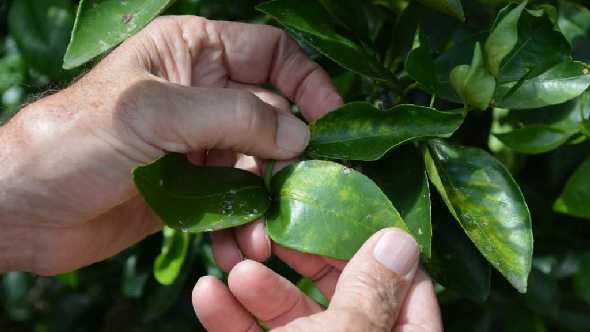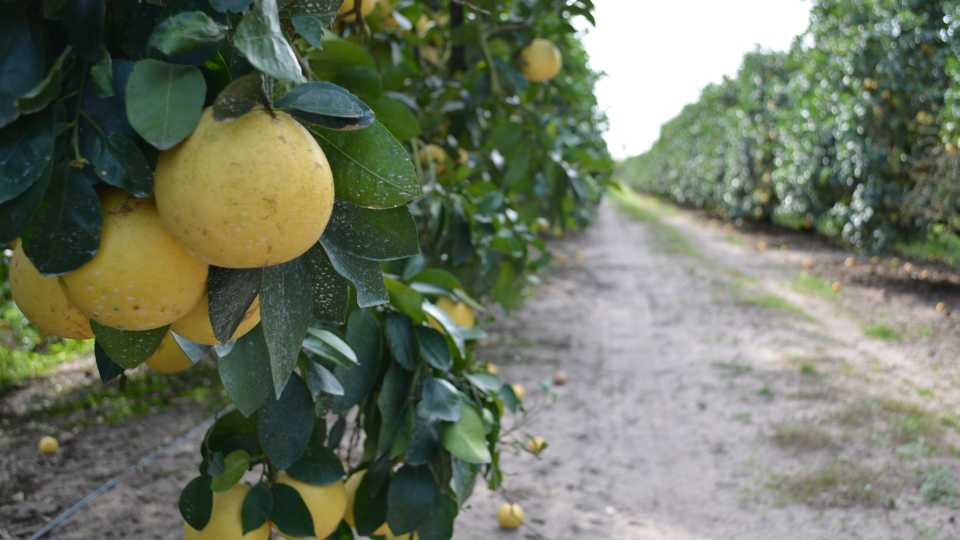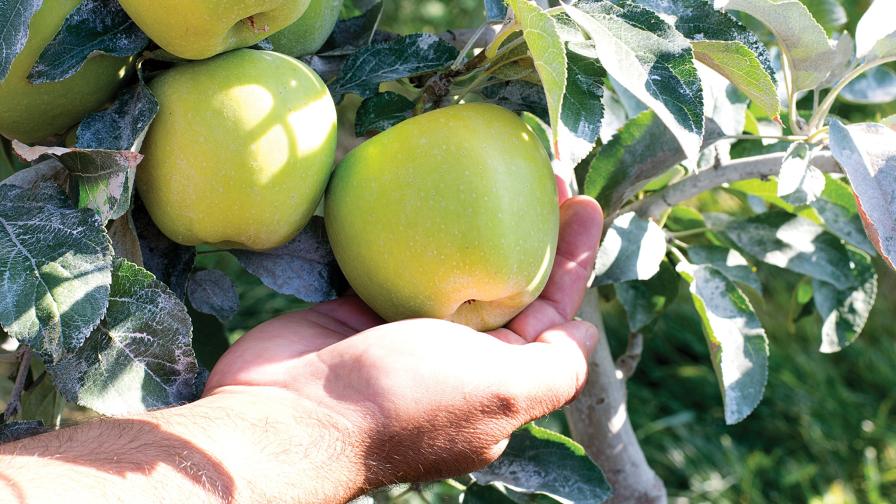What We Know Now About Citrus Nutrition
Citrus greening has changed how Florida growers view fertilizer and nutrition programs entirely. Over the past decade, new ground and foliar mixes and matches have been tested, and growers continue to fine tune applications with an eye on costs and production.

Photo by Frank Giles
Serving as Florida’s BMP coordinator, Dr. Kelly Morgan, an Associate Professor of soil fertility and water management, has observed citrus nutrition practices evolve since greening established its foothold.
“It has been a night and day change in the way we view citrus nutrition,” he says. “Back before greening, we felt like we had everything pretty much figured out. We had well-defined recommendations for the macronutrients, and growers were having good results with those practices.”
Micronutrient recommendations for elements such as manganese, zinc, and boron went back to the 1970s and appeared to be working. The minors were not viewed back then as changing much in plant growth and production, but were important to fight deficiencies.
Everything Changed
According to Morgan, what was fairly settled when it came to citrus nutrition changed with greening.
“We are uncertain what our nitrogen, phosphorus, and potassium rates should be with greening,” he says. “Currently, we are maintaining the same recommendations before greening, because we don’t have the data to determine these nutrition rates are the best thing for the trees.
“We assume because production is down we are probably over-fertilizing the trees and possibly wasting or leaching nutrients, but we don’t have the data to support this conclusion. So, we are not recommending growers use less nutrients for the same reason.”
Morgan says a number of studies are being conducted across the state to build data on how fertility programs can or should be adjusted in the face of greening.
Foliar Before Greening
As greening spread, foliar nutrition became the rage, driven in part by the positive results demonstrated by Maury Boyd using his foliar nutrition cocktail on his Orange Hammock grove in Felda. Boyd’s program not only includes nutrition but also products to boost systemic acquired resistance (SAR) to fight back the effects of greening.
“There was always a recommendation to apply foliar micronutrients on the trees once per year to correct any possible deficiencies,” Morgan says. “Some growers were very faithful and always did it. However, some applied it if they remembered and some didn’t do it at all.”
But greening changed the approach to foliar nutrition and it has become a standard practice with multiple applications per year with all manner of mixes. But, have growers gone too far, applying more fertilizer than needed or is effective?
“Getting the micronutrient levels back into the optimal range is certainly beneficial to the trees,” Morgan says. “With the applications, the nutrient deficiency symptoms have gone away, but the greening has not. That is the best growers can do with this disease.”

Photo by Frank Giles
Crunching Data
Morgan and Dr. Bob Rouse, a retired Horticulturist with UF/IFAS, conducted a five-year study comparing four different rates of manganese, boron, and zinc. There was a zero rate where trees received nothing. The second rate was half the UF/IFAS-recommended rate applied three times per year (1.5X recommended rate). The third was the UF/IFAS recommended rate applied three times per year (3X recommend rate). The fourth was a 2X rate applied three times per year (6X recommended rate).
“What we found over five years is there was very little effect on growth, but we did see some significant yield differences at the one UF/IFAS rate or three times the recommended rate for the year,” Morgan says. “Take manganese, for example, we found to get these leaves back into the optimal range, we needed to apply the one UF/IFAS rate three times — or three times the recommended rate before greening.”
Measure First
Just because the research shows higher rates of micronutrients might improve yields, Morgan says growers should always scout fields and rely on soil and leaf tissue analysis.
“What I am recommending to growers is rather than going out and spraying large amounts of micronutrients, I suggest they pay very close attention to their leaf analysis,” he says. “If whatever they are doing is keeping the leaves in the optimal range for the micronutrients, they should keep doing it. If they are a little below optimal, they need to apply a little more. Likewise, if the analysis is showing above optimal range, they can back off a bit.”
Morgan acknowledges there is some debate about what is optimal in greening-infected trees. Research trials are under way to get a better handle on this question.
“We want to see if there is any benefit of going above optimal leaf concentrations. Because of all the starch accumulation in the leaves because of greening, it might require more nutrients,” Morgan says. “We have seen in the trials that when we have used the highest rate of micronutrients, the level rose about optimal range in leaf analysis, but without any increase in production, so we believe staying in the optimal range is probably OK.”
pH Factor
Before greening, researchers and growers knew there were some pH issues in groves due to high pH irrigation water. High pH makes nutrients less available to the trees. Morgan says a study was conducted in the late 1990s at Conserv II in Orange County to look at changing pH under trees to see if it would increase growth and yield.
“The results of the study in the 1990s was that pH didn’t seem to be a problem for healthy trees,” he says. “But, with greening, pH definitely matters. The availability of most nutrients is affected by pH levels and should be below a pH of 7.0.
“This is why Dr. Jim Graham, (a Professor of soil microbiology with UF/IFAS) and I have been working with growers to acidify water and soil to get the pH levels down. This work also has shown the importance of spoon feeding ground fertilizer, because root systems are so diminished by greening.”
Morgan says there are a lot of groves in the 7 to 7.5 pH range, which is too high. The optimum range for nutrient uptake is in the 5.5 to 6.5 pH range.
“One of the problems we have seen is if you have high copper in your soils from fungicides, you don’t want the copper to become more available,” he says. “If you have high copper, then you want to keep the pH toward the upper range of 6.5. If you don’t have high copper, you can shoot for the 5.5 to 6 pH range. We have really been cautioning growers about this.”
Boyd’s Take On Nutrition
 While foliar nutrition of citrus has been around well before greening, Maury Boyd put the practice on the front burner with his “cocktail” of nutrients to fight the effects of greening.
While foliar nutrition of citrus has been around well before greening, Maury Boyd put the practice on the front burner with his “cocktail” of nutrients to fight the effects of greening.
Boyd’s program was featured as the cover story in Florida Grower® magazine in January 2009. He also was awarded the Citrus Achievement AwardSM for his work in 2011. Boyd’s program has evolved some over the years, but still relies on applying everything known to make plants grow and yield.
“We apply all the known minerals plants require including a trace amount of nickel,” Boyd says. “All the foliage is sprayed and what falls to the ground will be absorbed by the roots. It does not work in reverse with HLB.
“HLB interferes with the phloem, which is the vehicle that citrus tree uses to transmit minerals/nutrients. Since there is an obstruction occurring, enough of these nutrients are not reaching their intended site.”
Therefore, Boyd applies all the nutrients and minerals throughout the tree’s seasonal growing period targeting the emerging and expanding flush for optimal uptake. In the mix, is a systemic acquired resistance (SAR) called SAver.
“Plant Food Systems has a patent on the SAR material and added to their K-Phite and a liquid NPK fertilizer, calling it ‘Renew,’” he says.
Boyd says he almost is exclusively using calcium nitrate as the ground source for nitrogen, partly to address blight in groves. In addition, Boyd applies boron, which helps eliminate some blight symptoms like corky veins and green oblong fruit.
Bactericides Take Center Stage
While bactericides are not nutrition products, growers hope they will help improve the health of HLB-infected trees. In March, Commissioner of Agriculture Adam Putnam issued a crisis declaration for two products from AgroSource — FireWall 50 (streptomycin) and FireLine 17 (oxytetracycline). The third is NuFarm’s Mycoshield (oxytetracycline).
Foliar application of these products result in an actual reduction of the HLB bacteria in trees. The hope is, in combination with nutrition and other cultural practices, the bactericides will help trees recouperate from the disease to some extent and help curb declining production.
While there is some concern over public reaction to the use of antibiotics on the plants, the crisis declaration was deemed necessary to address production that has fallen well below 100 million boxes. And, they are being used in agriculture already.
The main uses for both oxytetracycline and streptomycin sulfate in agriculture are for prevention of fire blight in apples and pears. Streptomycin is the preferred bactericide, since it is kills the bacteria on contact (bactericidal), whereas oxytetracycline is “bacteriostatic,” suppressing bacterial growth. Bacteriostatic bactericides require a longer duration of exposure to suppress growth long enough to reduce the bacterial titer. Alternating chemicals with different modes of action is the primary strategy for resistance management.1
The Citrus Research and Development Foundation (CRDF) provided funding for the research data on the use of these bactericides. In a letter to industry, CRDF COO Harold Browning noted: “As with all agricultural tools, it is critically important that growers begin their use of these products with stewardship in mind, considering the importance of rotation of active ingredients for resistance management, adherence to rates, application timing, intervals between applications, and pre-harvest intervals.”
1“The Use Of Bactericides In Plant Agriculture With Reference To Use In Citrus To Mitigate HLB” by Stephanie L. Slinski, Ph.D, Bactericide Project Manager, CRDF










